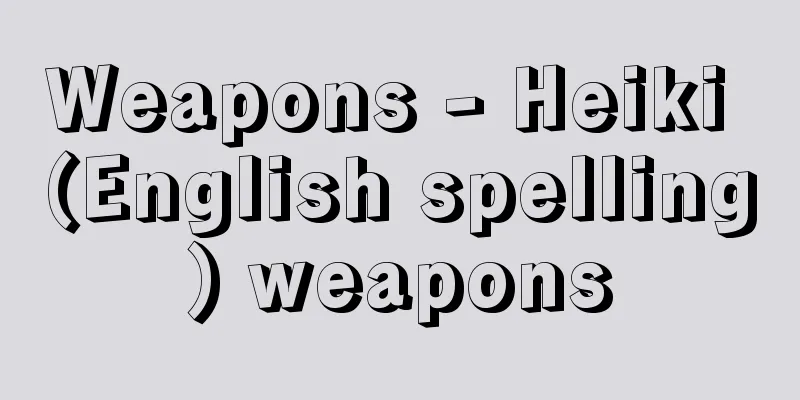Weapons - Heiki (English spelling) weapons

|
A general term for equipment used to attack or defend against an enemy. In the narrow sense, it refers to equipment that can cause harm, but in the broad sense, it includes equipment that does not have the ability to cause harm, such as various electronic warfare weapons and C4I (Command, Control, Communication, Computer and Intelligence) systems. The former are sometimes called weapons, but the latter are not. Modern weapons incorporate the results of physics and chemistry, such as nuclear energy, to increase their destructive and lethal power, forming a series of attack and defense systems, and they are not only becoming more precise and faster, but also becoming more automated and robotic through the application of computers, as seen in the Tomahawk cruise missile with a terrain matching guidance system. Today, computers and sensors account for almost half of the cost of weapons, aircraft, and ships, and information processing capabilities have come to dominate the capabilities of weapon systems. [Takashi Takano] ClassificationModern weapons can be classified in various ways based on the physical or chemical phenomena they apply, the type of energy they use, and their intended purpose, but the most common classifications are weapons of mass destruction and conventional weapons (non-nuclear weapons). (1) Weapons of mass destruction Weapons with particularly strong destructive power and large impacts when used include nuclear weapons, radioactive (radiation) weapons, chemical weapons, and biological (bacteria) toxin weapons, which are often delivered by long-range ballistic missiles. Nuclear weapons include various atomic hydrogen bombs and nuclear warheads, radioactive weapons include neutron bombs (radiation-enhanced bombs), the "dirty hydrogen bomb" from the early Cold War that produced a large amount of lethal fallout, and cobalt bombs that remained only in concept form, and chemical weapons include the old asphyxiating and blistering gases, sarin, and nerve gases such as VX. Following the Biological and Toxin Weapons Convention of April 1972, the Chemical Weapons Convention of January 1993 prohibited the development, production, storage, and use of chemical weapons, and decided to destroy them within 10 years. (2) Conventional Weapons There are many types of conventional weapons, including attack aircraft, bombers, reconnaissance aircraft, airborne early warning and control aircraft (AWACS), and various air defense missile systems in the air, nuclear-powered and other aircraft carriers and submarines, missile-equipped cruisers, destroyers, and frigates, and Aegis ships capable of handling various anti-ship missile attacks, and tanks, armored fighting vehicles, multiple rocket launchers, anti-tank guided weapons, attack helicopters, etc. Many of these are operated as a complex system under C4I , and various missile systems are used for direct attack and defense. Modern weapons systems are complex and cannot be neatly categorized, but optical weapons include various infrared homing missiles, laser-guided bombs, and TV-guided bombs. Laser-guided bombs (also called "smart weapons"), which appeared during the Vietnam War, had high accuracy and promoted the remarkable development of precision-guided weapons (PGMs). Radio and electronic weapons include various radars and electronic countermeasures (ECM). Electric and magnetic weapons include anti-submarine magnetic detectors and magnetic mines, and acoustic weapons include anti-submarine sonar. X-ray laser guns for the Strategic Defense Initiative (SDI), which was conceived in the United States in the 1980s, and particle beam weapons that accelerate particles in particle accelerators used in physics research to intercept missiles (collectively called directed energy weapons) can be considered physical weapons, regardless of their feasibility. Depleted uranium bullets, which were used in large quantities for the first time in the Gulf War in 1991 to penetrate the armor of tanks and other vehicles, can in a sense also be included in the category of physical weapons. Weapons of environmental destruction include Agent Orange, which was used in large quantities in the Vietnam War, but its use was banned by the Environmentally Destructive Weapons Convention of May 1977. As for optical weapons, laser weapons (guns) designed to attack enemy soldiers and cause permanent blindness were included in the Fourth Protocol to the Convention on Certain Conventional Weapons in October 1995, following certain cluster bombs, land mines, booby traps, and incendiary weapons, and their use is now prohibited. (3) Weapons can also be divided into strategic weapons, theater weapons, tactical weapons, anti-aircraft weapons, anti-submarine weapons, etc. according to the purpose of their use, and into land weapons, naval weapons, air weapons, underwater weapons, undersea weapons, space weapons, etc. according to the place of use. Strategic weapons are weapons capable of devastating an entire country for the purpose of attack or deterrence, and include long-range nuclear ICBMs (intercontinental ballistic missiles), SLBMs (submarine-launched ballistic missiles), and strategic bombers. Theater weapons are weapons designed for combat within a certain region, such as Europe. Various intermediate-range ballistic missiles (IRBMs) were developed and deployed during the Cold War, but the United States and the Soviet Union eliminated these missiles in the Intermediate-Range Nuclear Forces (INF) Treaty of 1987. Tactical weapons are weapons used on the battlefield, and there are various types as described in the "conventional weapons" section. In the early Cold War, many of them were equipped with small nuclear warheads, and atomic cannons were also created, but most were removed due to the possibility that their use could escalate into a full-scale nuclear war. The Tomahawk cruise missile is used as a strategic/theater weapon equipped with a nuclear warhead, and as a tactical weapon equipped with a conventional warhead. Anti-aircraft weapons include airborne early warning and control aircraft (AWACS), various surface-to-air missiles (SAM), and anti-aircraft artillery, while ballistic missile defense weapons include the BMD (Ballistic Missile Defense) system currently being researched and developed by Japan and the United States. BMD is divided into three sections, the flight path of a ballistic missile: the boost phase, the midcourse phase, and the terminal phase, and interception systems suitable for each phase are being researched and developed. Anti-submarine weapons include anti-submarine patrol aircraft loaded with various electronic devices, anti-submarine sonar, anti-submarine rockets, and depth charges. Undersea weapons do not yet exist in reality, and the February 1971 Seabed Military Use Treaty prohibited the laying of nuclear weapons and other weapons of mass destruction on the seabed. Space weapons are weapons used in outer space, and since the late 1950s various photoreconnaissance satellites, electronic reconnaissance satellites (spy satellites), military communications satellites, GPS (Global Positioning System) which notifies the location of submarines, and early warning satellites which capture infrared rays from enemy missiles to detect their launch at an early stage have been launched, and photoreconnaissance satellites in particular are said to have a resolution of several tens of centimeters for objects on the ground, revolutionizing the collection of military intelligence worldwide. In the 1980s, anti-satellite weapons (ASATs) were tested as weapons to attack these vulnerable military satellites, and there were concerns that they would destabilize the US-Soviet nuclear strategic system and increase the risk of nuclear war. The Strategic Defense Initiative (SDI), a representative space weapons system, was shelved due to the end of the Cold War and technical difficulties, but the ABM Limitation Treaty concluded in 1972, which restricted the deployment of ABMs (anti-ballistic missiles) by the United States and the Soviet Union to intercept targets outside the atmosphere, remains important today as a means of preventing an escalation of the arms race in outer space. [Takashi Takano] Precision and SystematizationDuring the Cold War, conventional weapons were overshadowed by nuclear weapons and did not stand out much, but in the meantime, their destructive and lethal power has increased immensely, spread far and wide, and been used in countless wars in ways that violated international law, causing many casualties. One example is the Vietnam War in the 1960s, in which various attack helicopters and high-speed rifles, as well as highly lethal cluster bombs, vapor bombs, laser-guided bombs, anti-personnel mines, various sensors, and C3I systems were tested and put into practical use. Laser-guided bombs use a laser beam to illuminate a target from an aircraft, capture the reflected light, and drop accurately on the target. There are also systems that equip bombs and missiles with television cameras, which can be used to accurately guide the bomb to the target by viewing the image from the aircraft, virtually eliminating the impact error, thereby increasing their destructive and lethal power. The Tomahawk cruise missile initially flies using an inertial guidance system, then flies in a zigzag pattern at low altitude to avoid enemy radar, scans the terrain with a camera in a terrain matching guidance system called TERCOM, compares the computer image with a stored image to correct its flight course, and finally dives into the target using a homing radar, with the impact error said to be within 30 meters. In today's highly high-tech warfare, these automated and robotic high-performance weapons are combined in various ways according to various military requirements to form a single attack system, which is used almost automatically under the control of a C4I system that commands the entire system. This process includes, for example, confirmation and identification of the enemy's position by collecting information from various sensors, decision-making using computers, the use of various guided weapons based on that decision, and evaluation of the effects. This method of warfare was demonstrated on a large scale by multinational forces in the Gulf War in 1991. In this war, F-117 stealth fighter planes, which have stealth technology to avoid detection by enemy radar, were also deployed. Another military aircraft that takes stealth into consideration is the B-2 stealth bomber. [Takashi Takano] Regulation of conventional weaponsDiscussions on regulating not only weapons of mass destruction but also conventional weapons began to take place little by little around the time of the Treaty on the Prohibition of Certain Conventional Weapons (signed in 1980), and in Europe, in connection with the Conference on Security and Cooperation in Europe (CSCE) process, NATO and the member states of the Warsaw Pact signed the Conventional Forces in Europe (CFE) Treaty in the fall of 1990, and in subsequent negotiations set upper limits on the number of tanks, armored fighting vehicles, artillery, combat aircraft, and attack helicopters that each country could deploy. This treaty is based on the idea that, with regard to conventional weapons as well, excessive offensive power would actually undermine the security of both sides, and that emphasis should be placed on defensive weapons. On the other hand, large-scale arms exports from industrialized countries such as the United States and Russia have continued even after the Cold War, stimulating an arms race among Third World countries and fueling conflicts by flooding developing countries with cheap small arms and landmines. The value of major conventional arms exports, just those known to exist, exceeds US$20 billion annually, even in the 1990s. In 1992, at the suggestion of Japan and the European Community (EC), a Conventional Arms Transfer Registration System was launched, which requires transfers of tanks, armored fighting vehicles, large-caliber artillery, combat aircraft, attack helicopters, warships, and missiles to be registered with the United Nations, but registration is still left to the discretion of each country. [Takashi Takano] Landmine contaminationAlthough the use of landmines was banned by Protocol II of the Convention on Certain Conventional Weapons (the so-called Landmine Protocol), due in part to the increase in internal conflicts in the Third World after the Cold War, as of 1997, the United Nations estimated that as of that time, 110 million imported landmines remained in place in over 60 countries around the world, including Cambodia, Angola, Somalia, and Afghanistan, and even after the conflicts ended, they continue to kill and injure more than 20,000 people every year (half of whom were curious children), impede agriculture, and retard development. Most of these are anti-personnel mines designed to injure humans, and although anti-personnel mines are simple and not considered high-tech weapons, there are many types, and some are designed with various ingenuity, such as not reacting to strong impacts but only exploding when a human steps on them. In the mid-1990s, it was known that 35 countries were exporting landmines, and in December 1997, the Anti-Personnel Mines Ban Treaty was concluded, which prohibits the use, stockpiling, production, and import of anti-personnel mines on humanitarian grounds, and requires that buried mines be removed within 10 years of the treaty's entry into force. However, major powers such as the United States have refused to sign the treaty for various reasons, and small plastic anti-personnel mines with little metal content are particularly difficult to detect, so removal is currently only possible through human wave tactics, and it can cost as much as 1,000 US dollars to remove a mine that costs 3 US dollars each. As of 1997, about 100,000 mines are being removed each year, but at this rate, it will take more than 1,000 years to completely remove all anti-personnel mines, even if no new mines are laid, and international support for removal and for the increasing number of victims is necessary. [Takashi Takano] "The Path to Sanity" by Alva Myrdal, translated by Toyoda Toshiyuki and Takanoki Takashi (1978, Iwanami Shoten)" ▽ "Armaments and Disarmament in the Nuclear Age, edited by Stockholm International Peace Research Institute, translated by Hattori Manabu (1979, Jiji Press)" ▽ "Strategic Arms Reduction Negotiations: The End of the Cold War and the Construction of a New Strategic Relationship" by Saito Naoki (1994, Keio Press)" ▽ "Usable Weapons, Unusable Weapons, Volumes 1 and 2 by Ebata Kensuke (1997, Namiki Shobo)" ▽ "Common Sense and Nonsense About Weapons, Volumes 1 and 2 by Ebata Kensuke (1998, Namiki Shobo)" ▽ "Encyclopedia of Modern Weapons" by Mino Masahiro and Fukagawa Takayuki (1998, Asahi Sonorama)" ▽ "Illustrated History of the Development of Air Combat Weapons: From World War I to the Gulf War" by Kimata Shigeo (1998, Green Arrow Publishing) ▽ Masatsugu Noka and Tetsuya Umemoto (eds.), International Politics of Non-Proliferation of Weapons of Mass Destruction (2000, Yushindo Kobunsha) ▽ Akira Sakamoto, Illustrated Guide to the World's Missile and Rocket Weapons (2001, Green Arrow Publishing) ▽ Kazumi Murakami, The Full Picture of Chemical Weapons: The Resurgent Threat of Weapons of Mass Destruction (2004, Ariadne Planning, Sanshusha Publishing) ▽ Mitsuru Kurosawa (ed.), Disarmament Theory of Weapons of Mass Destruction (2004, Shinzansha Publishing, University Tosho Publishing) ▽ Gen Koto, Encyclopedia of Nuclear Weapons (2005, Shinkigensha) ▽ Takanori Takano, Modern Nuclear Weapons (Iwanami Shinsho) ▽ Strategic Weapons (1995, Janes Information Group) ▽ Stokholm International Peace Research Institute: Sipri Yearbook 1998 Armaments, Disarmament and International Security (1998, Oxford University Press)" ▽ "Paul Jackson: Jane's All the World's Aircraft 1998-99 (1998, Janes Information Group)" ▽ "Richard Sharpe: Jane's Fighting Ships 1998-99 (1998, Jane's Information Group)" ▽ "Non-Lethal Weapons (1999, Janes Information Group)" ▽ "Terry Gander: Jane's Infantry Weapons 1999-2000 (1999, Janes Information Group)" [References] | | | | | | | | | | | | | | | Mines| | | | | | | | | |Source: Shogakukan Encyclopedia Nipponica About Encyclopedia Nipponica Information | Legend |
|
敵を攻撃したり、防御するのに使う器材の総称。狭義には加害力をもつ器材をさし、広義には各種の電子戦兵器やC4I(Command, Control, Communication, Computer and intelligence=指揮・管制・通信・コンピュータおよび情報)システムなど、直接の加害力をもたない器材も含む。前者を武器とよぶこともあるが後者は武器とはよばない。現代の兵器は核エネルギーなど、あらゆる物理、化学の成果を導入して破壊力、殺傷力を高めて一連の攻撃・防御システムを形成し、精密化、高速化しているだけでなく、地形照合誘導装置をもつ巡航ミサイルのトマホークにみられるように、コンピュータの応用による自動化やロボット化が進み、いまではコンピュータやセンサーが兵器、航空機、艦船のコストのほぼ半分を占め、情報処理能力が兵器体系の能力を支配するようになった。 [高榎 堯] 分類現代の兵器は応用する物理・化学現象やエネルギーの種類や使用目的によってさまざまに分類することができるが、もっとも一般的な分類としては、大量破壊兵器と通常兵器(非核兵器)がある。 (1)大量破壊兵器 破壊力がとくに強大で使用の影響が大きく、核兵器、放射能(放射線)兵器、化学兵器、生物(細菌)毒素兵器があり、これらは長距離弾道ミサイルなどで運搬されることが多い。核兵器としては各種の原水爆や核弾頭、放射能兵器としては中性子爆弾(放射線強化爆弾)や大量に死の灰を発生する冷戦初期の「汚い水爆」や構想にとどまったコバルト爆弾、化学兵器としては古くからの窒息性、びらん性のガスやサリン、VXなどの神経ガスがある。化学兵器は1972年4月の生物毒素兵器禁止条約に続いて、93年1月の化学兵器禁止条約で開発、生産、貯蔵、使用を禁止し、10年以内に廃棄することが決まった。 (2)通常兵器 空では各種の攻撃機、爆撃機、偵察機、空中早期警戒管制機(AWACS(エーワックス))や各種の防空ミサイルシステム、海では原子動力そのほかの航空母艦や潜水艦、ミサイル搭載の巡洋艦、駆逐艦、フリゲート艦、各種の対艦ミサイル攻撃に対応するイージス艦、陸では戦車、装甲戦闘車両、多連装ロケットシステム、対戦車誘導兵器、攻撃ヘリコプターなど、種類が多い。その多くがC4Iのもとで一個の複雑なシステムとして運用され、直接の攻撃・防御には各種のミサイルシステムが使われる。 現代の兵器体系は複雑で、すっきりと分類することは不可能だが、光学兵器としては赤外線などによる各種のホーミング(追尾)・ミサイルやレーザー誘導、テレビ誘導の爆弾やミサイルがある。ベトナム戦争のときに登場したレーザー誘導爆弾(これは利口な爆弾という意味で「スマート兵器」などとよばれる)は命中精度が高く、その後のこうした精密誘導兵器(PGM=Precision Guided Munitions)の著しい発達を促した。電波兵器・電子兵器としては各種のレーダーや対電子戦機器(ECM)がある。電気兵器・磁気兵器としては対潜磁気探知器や磁気機雷があり、音響兵器としては対潜ソナーがある。1980年代にアメリカで構想されたSDI(戦略防衛構想)用のX線レーザー砲や、物理学研究に使うような粒子加速器で粒子を加速してミサイルを迎撃する粒子ビーム兵器(これらは一括して指向性エネルギー兵器とよばれる)は、実現の可能性は別として、物理兵器といえそうである。91年の湾岸戦争で戦車などの装甲貫徹用に初めて大量に使われた劣化ウラン弾もある意味では物理兵器に含めうる。環境破壊兵器としてはベトナム戦争で大量に使われた枯れ葉剤などがあげられるが、1977年5月の環境破壊兵器禁止条約で使用が禁止された。光学兵器については95年10月に相手の兵士を攻撃して恒久的に失明させる目的のレーザー兵器(銃)が、ある種の集束爆弾や地雷、ブービートラップ(仕掛け爆弾)、焼夷(しょうい)兵器に続いて特定通常兵器使用禁止条約第4議定書に取り上げられて、使用が禁止されることになった。 (3)兵器はまた使用目的によって戦略兵器、戦域兵器、戦術兵器、対空兵器、対潜兵器などに、また使用場所によって陸戦兵器、海戦兵器、航空兵器、水中兵器、海底兵器、宇宙兵器などに分けることができる。 戦略兵器は攻撃や抑止の目的で相手の国全体を荒廃させる能力をもつ兵器で、長射程の核ICBM(大陸間弾道ミサイル)やSLBM(潜水艦発射弾道ミサイル)、戦略爆撃機などからなる。戦域兵器はたとえばヨーロッパなど一定の地域内での戦闘を想定した兵器で、冷戦中に各種の中距離弾道ミサイル(IRBM)が開発され、配備されたが、米ソは1987年の中距離核戦力(INF)全廃条約で、それらのミサイルを廃棄した。戦術兵器は戦場で使用される兵器で、「通常兵器」の項で述べたようなさまざまなものがあり、冷戦期の初期にはその多くは小型の核弾頭が装備され、原子砲もつくられたが、その使用が全面的な核戦争にエスカレートする可能性があり、ほとんど撤去された。巡航ミサイルのトマホークは核弾頭を装備して戦略・戦域兵器に、また通常弾頭を装備して戦術兵器として使われる。対空兵器としては空中早期警戒管制機(AWACS)や各種の対空ミサイル(SAM)、対空火砲があり、弾道ミサイル防衛兵器としては日米が研究開発中のBMD(弾道ミサイル防衛)システムなどがある。BMDは弾道ミサイルの飛行経路である「ブースト段階」「ミッドコース段階」「ターミナル段階」の3部門に分かれており、各段階に適した迎撃システムが研究開発されている。対潜兵器としては各種の電子機器を満載した対潜哨戒(しょうかい)機や対潜ソナー、対潜ロケット、爆雷などがある。海底兵器は現実にはまだ実在せず、1971年2月の海底軍事利用禁止条約で海底に核兵器そのほかの大量破壊兵器を敷設することが禁止された。 宇宙兵器は宇宙空間で使用される兵器で1950年代末から各種の写真偵察衛星や電子偵察衛星(スパイ衛星)、軍事通信衛星、潜水艦などに位置を知らせるGPS(全地球測位システム)、相手のミサイルからの赤外線をとらえてその発射を早期に探知する早期警戒衛星などが打ち上げられ、なかでも写真偵察衛星は地上の物体の解像力が数十センチメートルといわれ、世界的な軍事情報の収集に革命をもたらした。80年代にはそれらの脆弱(ぜいじゃく)な軍事衛星を攻撃する兵器として、対衛星攻撃兵器(ASAT(エーサット))がテストされ、米ソの核戦略体系を不安定にさせ、核戦争の危険を高めることが懸念された。代表的な宇宙兵器体系であるSDI(戦略防衛構想)は冷戦の終結や技術的困難で棚上げの形になったが、1972年に米ソの大気圏外で相手を迎撃するABM(弾道弾迎撃ミサイル)の配備を制限するABM制限条約を締結したことは、宇宙空間での軍備競争のエスカレーションを防ぐものとして、いまでも重要な意味をもっている。 [高榎 堯] 精密化とシステム化冷戦期には核兵器の陰に隠れてあまり目だたなかったが、通常兵器もその間に破壊力や殺傷力を限りなく高め、はるかに広く拡散し、数限りない戦争で国際法に違反するような方法で実際に使われて、多くの犠牲者を出してきた。その例の一つが1960年代のベトナム戦争で、この戦争では各種の攻撃ヘリコプターや高速ライフルをはじめ殺傷力の高い集束爆弾や気化爆弾、レーザー誘導爆弾、対人地雷、各種のセンサー、C3Iシステムがテストされ、実用化された。レーザー誘導爆弾は航空機上からレーザービームで目標を照射し、その反射光をとらえて目標に正確に落下する。爆弾やミサイルにテレビカメラを装備し、機上でこのイメージを見て目標に正確に誘導して着弾誤差を事実上ゼロにして、破壊力や殺傷力を高めるシステムもある。巡航ミサイルのトマホークは、最初は慣性誘導装置で飛行し、のちに低空をジグザグに飛行して相手のレーダーをかわし、TERCOM(ターカム)とよぶ地形照合誘導装置のカメラで地形を走査し、そのコンピュータ像を記憶している像と照合して飛行コースを修正し、最終的にはホーミング・レーダーを使って目標に突入するが、着弾誤差は30メートル以内といわれている。 現代の高度にハイテク化した戦争では自動化、ロボット化されたそれらの高性能の兵器が各種の軍事的要請に応じてさまざまに組み合わされて一つの攻撃システムを構成し、全体を指揮するC4Iシステムのもとでほとんど自動的に使用され、このプロセスにはたとえば各種のセンサーでの情報収集による敵の位置の確認や識別、コンピュータを使っての意思決定、それに基づく各種の誘導兵器の投入、効果の評価の各段階が含まれる。こうした戦争のやり方は1991年の湾岸戦争で多国籍軍によって大規模に実証された。また、この戦争では敵のレーダーなどに探知されないようにするステルス技術をもったF‐117ステルス戦闘機も投入された。ステルス性が考慮されている軍用機としては、ほかにB‐2ステルス爆撃機がある。 [高榎 堯] 通常兵器の規制大量破壊兵器だけでなく通常兵器の規制についても、特定通常兵器使用禁止条約(1980年調印)のころから少しずつ話し合いが行われるようになり、ヨーロッパではヨーロッパ安全保障協力会議(CSCE)のプロセスに関連して、90年秋にNATO(ナトー)(北大西洋条約機構)とワルシャワ条約機構加盟国がヨーロッパ通常戦力(CFE)条約に調印し、その後の交渉で戦車、装甲戦闘車、火砲、戦闘用航空機、攻撃ヘリコプターについて、各国が配備できる上限を決めた。この条約は通常兵器についても、過剰な攻撃力が逆に双方の安全を損なうので、むしろ防御的な兵器を重視すべきだという考え方に基づいている。 他方では冷戦後も米ロなど工業国からの大規模な武器輸出が続き、第三世界の国々の軍備競争を促進し、開発途上国に安価な小火器や地雷があふれて紛争をあおっている。おもな通常兵器の輸出額は1990年代に入っても、知られているだけで毎年200億米ドルを超えている。92年には日本やEC(ヨーロッパ共同体)の提案で通常兵器移転登録制度が発足し、戦車、装甲戦闘車、大口径火砲、戦闘用航空機、攻撃ヘリコプター、軍艦、ミサイルの移転が国連に登録されることになったが、登録はまだ各国の自主性にまかされたままである。 [高榎 堯] 地雷汚染特定通常兵器使用禁止条約の第2議定書(いわゆる地雷議定書)で地雷の使用が禁止されたにもかかわらず、冷戦後第三世界で国内紛争が増えたこともあって、国際連合の推定では1997年現在、カンボジア、アンゴラ、ソマリア、アフガニスタンなど、世界の60以上の国に1億1000万個もの輸入地雷が敷設されたままになり、紛争が終わってからも毎年2万人以上の人々を死傷させ(その半分が好奇心の強い子供)、農耕を妨げ、開発を遅らせている。その多くが人間に障害を負わせるための対人地雷で、対人地雷は簡単でハイテク兵器とはいえないが、種類が多く、なかには強い衝撃には反応しないで人間が踏んだようなときにだけ爆発するなど、さまざまな工夫がこらされているものもある。1990年代のなかばでは、35か国が地雷を輸出していることがわかっており、97年12月、人道的見地から対人地雷の使用、貯蔵、生産、輸入を禁止し、条約の発効から10年以内に埋設地雷を除去するという対人地雷全面禁止条約が結ばれた。だがアメリカなど大国はいろいろな理由で調印を拒み、また金属部分の少ない小型のプラスチック製の対人地雷などはとくに探知がむずかしく、除去はいまのところ人海戦術に頼るほかはなく、1個3米ドルの地雷を除去するのに1000米ドルもかかることがある。97年現在、毎年10万個ほどが除去されているが、このペースのままだと新たに地雷が敷設されなくても、対人地雷を完全に除去するのに1000年以上もかかる計算になり、除去や増える一方の犠牲者に対する国際的支援が必要になっている。 [高榎 堯] 『アルバ・ミュルダール著、豊田利幸、高榎堯訳『正気への道』(1978・岩波書店)』▽『ストックホルム国際平和研究所編、服部学訳『核時代の軍備と軍縮』(1979・時事通信社)』▽『斎藤直樹著『戦略兵器削減交渉――冷戦の終焉と新たな戦略関係の構築』(1994・慶応通信)』▽『江畑謙介著『使える兵器 使えない兵器』上下(1997・並木書房)』▽『江畑謙介著『兵器の常識・非常識』上下(1998・並木書房)』▽『三野正洋・深川孝行著『現代兵器事典』(1998・朝日ソノラマ)』▽『木俣滋郎著『大図解 空中戦兵器発達史――第一次世界大戦から湾岸戦争まで』(1998・グリーンアロー出版社)』▽『納家政嗣・梅本哲也編『大量破壊兵器不拡散の国際政治学』(2000・有信堂高文社)』▽『坂本明著『大図解 世界のミサイル・ロケット兵器』(2001・グリーンアロー出版社)』▽『村上和巳著『化学兵器の全貌――再燃する大量破壊兵器の脅威』(2004・アリアドネ企画、三修社発売)』▽『黒沢満編『大量破壊兵器の軍縮論』(2004・信山社出版、大学図書発売)』▽『小都元著『核兵器事典』(2005・新紀元社)』▽『高榎堯著『現代の核兵器』(岩波新書)』▽『Strategic Weapons(1995, Janes Information Group)』▽『Stokholm International Peace Research Institute:Sipri Yearbook 1998 Armaments, Disarmament and International Security(1998, Oxford University Press)』▽『Paul Jackson:Jane's All the World's Aircraft 1998-99(1998, Janes Information Group)』▽『Richard Sharpe:Jane's Fighting Ships 1998-99(1998, Jane's Information Group)』▽『Non-Lethal Weapons(1999, Janes Information Group)』▽『Terry Gander:Jane's Infantry Weapons 1999-2000(1999, Janes Information Group)』 [参照項目] | | | | | | | | | | | | | | | | | | | | | | | | |出典 小学館 日本大百科全書(ニッポニカ)日本大百科全書(ニッポニカ)について 情報 | 凡例 |
Recommend
Ahas-Els - Ahas-Els
…an eternally cursed wanderer in European legend....
Hydractinia epiconcha
Class Hydrozoa, Order Anthoathecata, Family Hydrid...
Kidera
Currently known as Renjo-ji Temple, this temple is...
Mortier, Gerard
Born: November 25, 1943, Ghent [Died] March 8, 201...
Impact crusher
...It is widely used for crushing raw materials i...
Gordianus III, Marcus Antonius
225‐244 Roman Emperor. Reigned 238-244. Son of Mae...
Ninohe [city] - Ninohe
The northernmost city in Iwate Prefecture. It was ...
Yanshu - Enshu
...This was designed so that the amount of water ...
Gyoki
?-? A member of the royal family of Baekje (Korea...
Three generations of formalities
This is a collection of Kaku and Shiki compiled du...
Hertzsprung-Russell diagram - Hertzsprung-Russell diagram
Also known as the HR diagram. A diagram in which e...
Buddha Mother - Butsumo
[1] (noun) Buddhist term. ① The law (dharma) that ...
Matilde di Canossa (English spelling)
...Pisa developed as a result of the Crusades in ...
Sekkanseiji - Regency politics
During the Heian period, the direct line of the F...
Claude Louis Berthollet
French chemist. Born into a family of immigrants ...





![Nishibiwajima [town] - Nishibiwajima](/upload/images/67cc6d42bbebd.webp)



